Bathroom Workbook: 13 Elements of Asian Style
Most of us can use more relaxation. The hospitality industry knows this, and that’s why it has responded accordingly with luxurious hotel rooms and calming spas. But who wants to wait around for that rare occasion of staying in a nice room or getting a massage?
Homeowners want to bring these relaxing experiences home, so they’re asking their designers and architects for spa-like refuges where they can relax, unwind and feel like they’re somewhere special. What they often end up with is a master bathroom that heavily draws on Asian influences, with a big focus on bathing and natural materials.
“Nature and people are more closely connected in Asian culture than Western, and to me that is the main factor of Asian style,” says Fumiko Faiman, an interior designer in Irvine, California, who was born and raised in Japan. “One of the powerful characteristics of Asian design is that they’re always trying to bring in nature or something that suggests the natural environment.”
Here are a few key elements of the style and how you can bring it home.
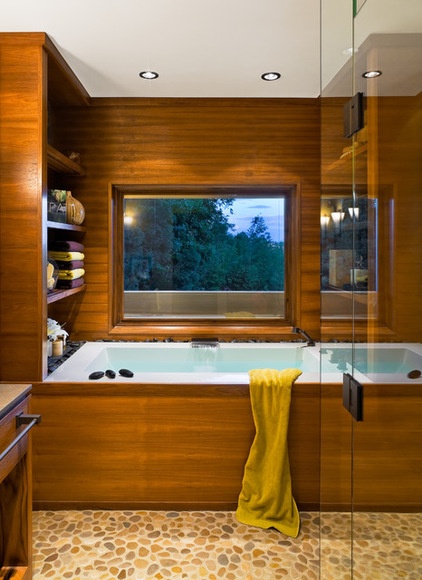
“Asian style” is a broad term and can mean different things to different people in different regions. For example, Asian style in Australia is less formal and has more roots in places like Bali, Indonesia and Thailand. In places like California, Asian style is much more influenced by the Japanese culture and aesthetic. What you’ll commonly find across most Asian styles is a respect for tradition, ceremony, peace and relaxation.
Separate water closet. “From spas, people have seen how bathing has been formalized and expanded to luxuriating in a tub that’s separate from where you brush your teeth,” says Josh Blumer, an architect and a designer who’s traveled throughout Asia and added the style to many of his clients’ homes in Southern California, including the one seen here. “The Japanese, for example, have had that as part of their culture for a long time. Bathing and cleaning happen separately.”
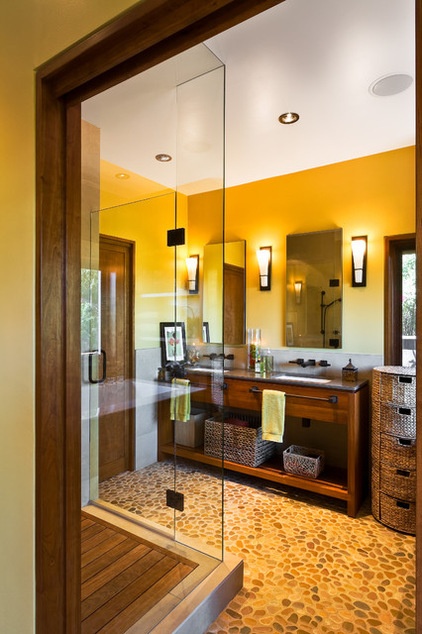
Neutral colors. Earth tones are most common, but when color is introduced it has an intense, natural energy to it. Think a fiery orange, like the sun, as seen here in another shot from Blumer’s bathroom design.
Built-by-hand quality. Vanities and bathtubs that look like pieces of furniture are common in this stye. “Almost everything in the space should look like it was built by hand,” Blumer says. “It harkens back to Asian craftsmen and the traditional vernacular construction that incorporated regional materials put together by hand — a lot of stone, wood, leather.”
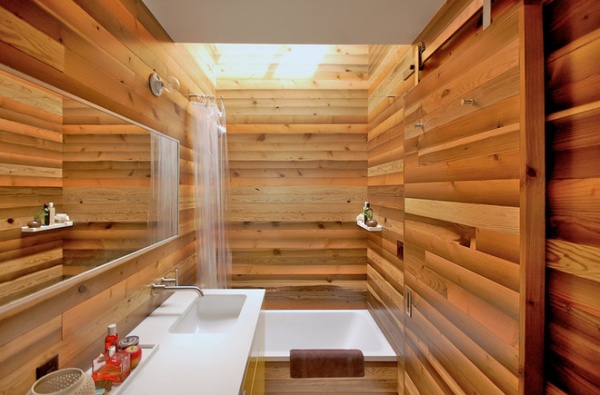
Wood surfaces. Nothing conveys the built-by-hand look more than wood. General contractor Cassie Couzzo took that idea to the extreme in this Portland, Oregon, bathroom. When a client asked for a “spa, Zen-like bathroom,” she worked with an architect to find natural materials that would convey that. They looked at photos and did some research and came up with the idea of wrapping the entire space in wood salvaged from a river dock. “We weren’t thinking, ‘Oh, we’re going to build a Japanese bath,’” Couzzo says. “But we started working, and that is what we felt should inspire us.”
Minimal, clean lines and a lack of clutter also drove the project, and pushed the design more in line with Asian style. “Even the carriage door was inspired by sliding Japanese-style rice paper doors,” Couzzo says.
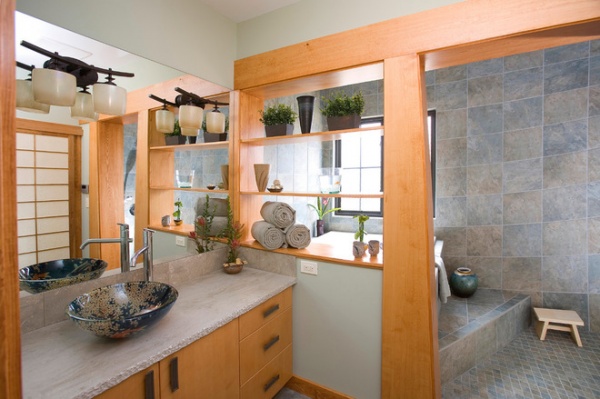
Other natural materials. Materials that are soothing and natural help create a state of relaxation, says Faiman. Mahogany, teak and large river stones are all common.
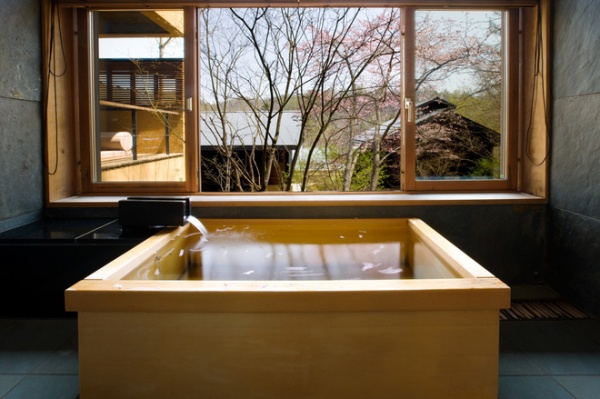
Focus on bathing. Bathing is an art form in Japan. “There are very few Japanese people who don’t appreciate bathing,” Faiman says, adding that it’s rare to see a home in Japan without a bathtub. Meanwhile, onsens, or hot springs, are extremely popular in Japan. People go there to soak outside in rock-surrounded springs where the focus is more on relaxing than cleansing. “It’s a bathing style that’s very popular today and has been for a thousand years,” Faiman says.
Spa-like. Blumer is noticing more requests for spa-like activities associated with Asian-style bathrooms. “A place to do yoga on a deck outside the bathroom, or even something as simple as a set of French doors that open to a little garden or reflecting tub — these are things you would find in a resort,” he says.
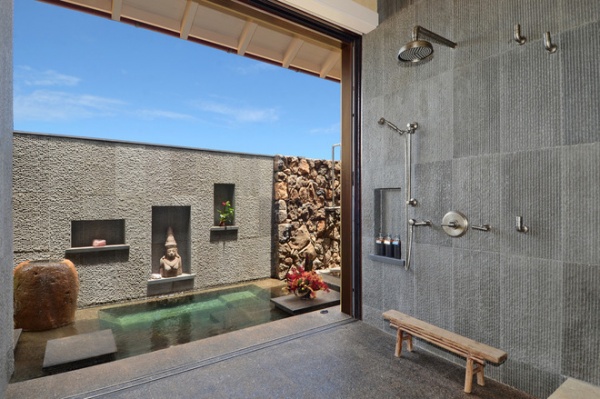
Connection to outside. Having some sort of connection to nature is key. It doesn’t have to be as extreme as in the photo seen here. But a window or skylight connecting to natural light and the outdoors is common.
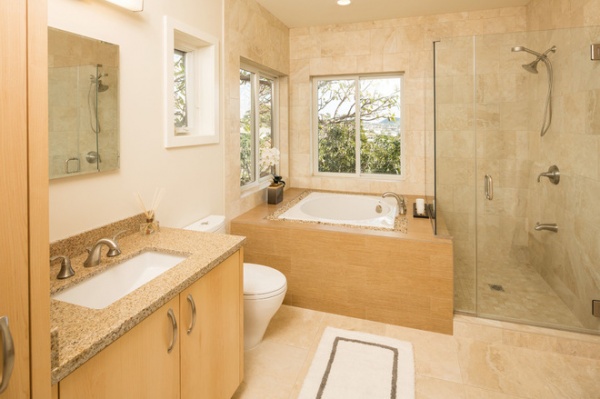
Focus on being. “In my experience, Eastern cultures are more concerned with being,” says Blumer. To accommodate this, a focus on harmony and meditation seems to be present in Asian-style spaces.
“The Western world calls it Zen style,” says Faiman. “That originated in Japan. It’s all about simplicity and beauty and nothing overly done. That’s what Japanese architecture and landscape design is based on: nature and materials in their purest form.”
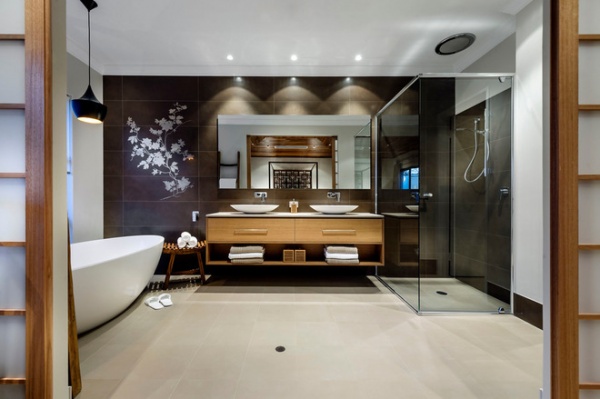
Lighting. Natural light is key, but so is control over light, like with dimmer switches to produce more calming moods for bathing.
Light fixtures tend to be rectilinear, Blumer says. “Going back to that traditional style of hand-built things, the designs had to support the materials, so squares and rectangles create more classical references.”
Be prepared. Spas always have plenty of towels and robes hanging around. This invites more activities surrounding the bathing process.
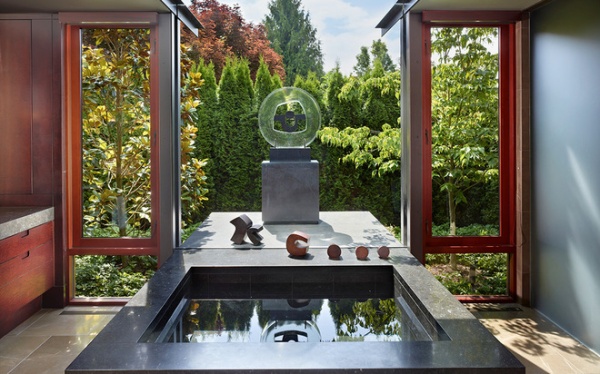
No fuss. “The Japanese, we appreciate simplicity,” Faiman says. “We keep a space simple and clean.”
Water and sound. Blumer recommends thinking about how water flows. Faucets that make a lot of noise can be distracting in a space that’s supposed to evoke calmness. “When you visit a spa, water pours out, not a harsh spraying sound,” he says.
Also consider incorporating music or the sound of a fountain inside or outside a window.
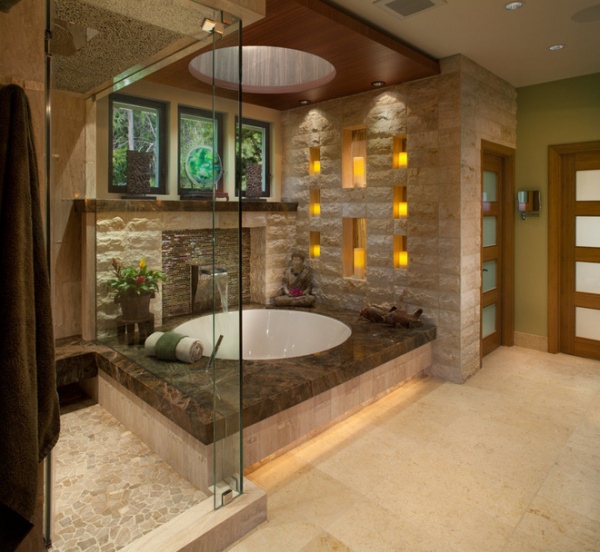
J.P. Walters designed this Asian-style bathroom in San Diego. (This photo has been added to more than 24,000 ideabooks on Houzz.) “When I imagine an Asian style, this instantly conjures a simple, tranquil space inspired by nature that quietly conveys a calming spirituality,” Walters says. “This effect is conveyed as much through sensation as through appearance.”
For his Asian bathrooms, he likes to include things like rain showerheads, deep soaking tubs and a place to recline. “And, ideally, views of inspiring art or a garden; a music system, fluffy, soft towels; a heated floor; a scented candle; the soothing sounds of an outdoor or indoor fountain; cultural art; or sculpture,” he says. “I envision a space designed to celebrate the daily grooming ritual by appealing to all the senses.”
For this space he went even further and added programmable mood lighting, automatic LED candles, heated floors and towel racks, and chromotherapy in the tub and shower.
More: Bathroom Workbook: 12 Things to Consider for Your Remodel












